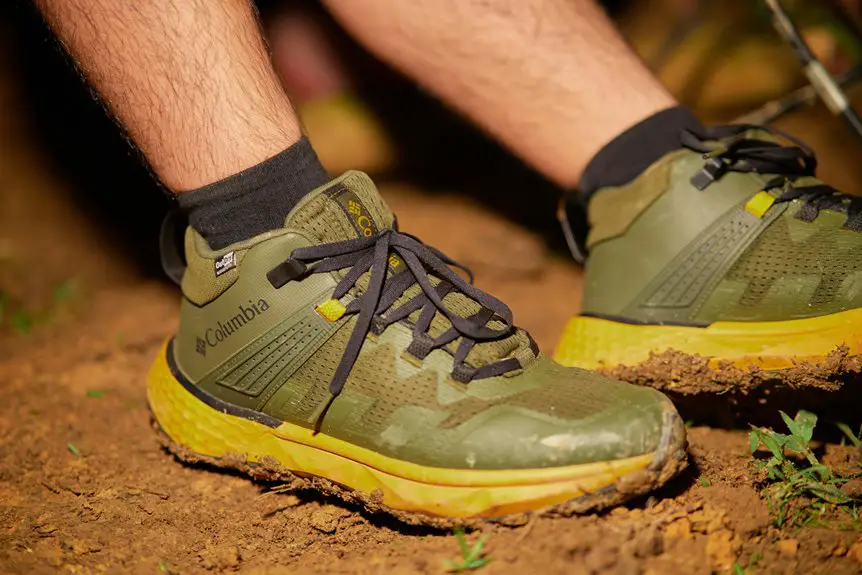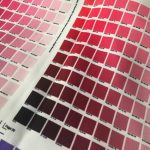Gore-Tex typically offers waterproof ratings between 20,000 and 28,000 mm, meaning it can handle heavy rain and snow without leaking. This high rating guarantees strong protection by blocking water while still letting moisture escape, keeping you dry and comfortable. Factors like proper layering, seam sealing, and maintenance also influence performance. To pick the right Gore-Tex gear for your activity and learn how to keep it performing at its best, keep exploring these important details.
Table of Contents
Key Takeaways
- Gore-Tex waterproof ratings are measured in millimeters indicating water pressure resistance the fabric can withstand without leaking.
- Typical Gore-Tex ratings range from 10,000 mm to over 30,000 mm, suitable for various rain intensities and outdoor activities.
- A 10,000 mm Gore-Tex rating is common and effective for moderate rain and general outdoor use.
- Higher Gore-Tex ratings (20,000 mm and above) offer protection for heavy rain, snow, and extreme weather conditions.
- Gore-Tex membranes balance waterproofing with breathability, allowing water vapor to escape while blocking liquid water.
Understanding Waterproof Ratings
Although waterproof ratings can seem confusing at first, understanding them helps you choose the right Gore-Tex gear for your needs.
The waterproof rating, measured in millimeters, indicates how much water pressure a fabric can withstand before leaking. For example, a 10,000 mm rating means the fabric can handle a 10,000 mm column of water pressing down on it without letting moisture in. The higher the number, the more waterproof the material is.
Keep in mind, though, that this rating doesn’t account for breathability or durability, which also matter when picking gear. By knowing the waterproof rating, you can match your Gore-Tex clothing or equipment to your activity and the weather conditions you expect, ensuring you stay dry and comfortable.
How Gore-Tex Technology Works
You’ll want to understand how Gore-Tex’s unique membrane keeps water out while letting sweat escape.
Its microscopic pores block liquid water but allow moisture vapor to pass through.
This balance is what makes Gore-Tex both waterproof and breathable.
Membrane Structure Explained
The key to Gore-Tex’s waterproof performance lies in its unique membrane structure. This membrane is made of expanded polytetrafluoroethylene (ePTFE), which has microscopic pores that are essential to its function.
Here’s how it works:
- The pores are about 20,000 times smaller than a water droplet, blocking liquid water from passing through.
- At the same time, these pores are roughly 700 times larger than a water vapor molecule, allowing moisture from sweat to escape.
- The membrane is bonded to fabric layers, creating a durable and flexible barrier.
- This structure guarantees you stay dry without sacrificing comfort or mobility.
Understanding this membrane helps you appreciate why Gore-Tex remains a top choice for waterproof gear.
Waterproof and Breathable Mechanism
Knowing how the Gore-Tex membrane blocks water while letting vapor escape sets the stage for understanding its waterproof and breathable mechanism.
When you wear Gore-Tex gear, the tiny pores in the membrane prevent liquid water from entering because water droplets are too large to pass through. At the same time, your sweat in vapor form has much smaller molecules, allowing it to move out through these pores.
This dual action keeps you dry from rain and snow while letting moisture from your body escape, preventing overheating and dampness inside. Gore-Tex works by balancing protection and comfort, so you stay dry both outside and in.
This clever design makes it ideal for outdoor activities where weather conditions can change quickly.
Measuring Waterproofness in Millimeters
You can measure waterproofness by looking at the millimeter rating, which shows how much water pressure the fabric can handle.
Understanding these mm ratings helps you compare different Gore-Tex products.
Let’s also look at the test methods used to determine these numbers.
Understanding Mm Ratings
Water resistance in fabrics often gets measured in millimeters, known as mm ratings, which tell you how well a material can withstand water pressure.
The higher the mm rating, the better the fabric resists water penetration. Here’s how you can understand these ratings:
- 5000 mm – Suitable for light rain and snow, offering basic protection.
- 10,000 mm – Great for moderate rain, typical of many Gore-Tex products.
- 20,000 mm – Handles heavy rain and prolonged exposure without leaking.
- 30,000+ mm – Offers extreme waterproofing, ideal for harsh conditions and heavy storms.
Knowing these numbers helps you choose the right gear for your needs, ensuring you stay dry during your outdoor adventures.
Waterproofness Test Methods
Mm ratings give you a clear idea of a fabric’s waterproof capabilities, but how do manufacturers determine these numbers?
They use standardized tests that measure how much water pressure a fabric can withstand before leaking. One common method involves placing the fabric under a vertical column of water and recording the height in millimeters when water starts to seep through. This simulates real-world conditions like rain or snow pressure.
Another test uses a spray test to see how well the fabric repels water on the surface. These methods guarantee the mm rating accurately reflects the material’s resistance to water penetration, helping you choose gear that keeps you dry in varying weather conditions.
Understanding these tests lets you trust the waterproof ratings you see on Gore-Tex products.
Interpreting Gore-Tex Waterproof Ratings
Although Gore-Tex products are renowned for their waterproof qualities, understanding their specific waterproof ratings can help you choose the right gear for your needs.
The rating, measured in millimeters (mm), indicates how much water pressure the fabric can withstand before leaking. Here’s how to interpret these numbers:
- 5,000 mm or less: Suitable for light rain and short exposure.
- 10,000 mm: Good for moderate rain and average outdoor activities.
- 20,000 mm: Ideal for heavy rain and extended use in harsh conditions.
- 28,000 mm and above: Designed for extreme weather and professional use.
Knowing these ratings guarantees you pick Gore-Tex gear that matches your activity level and weather challenges.
Comparing Gore-Tex to Other Waterproof Fabrics
When you’re choosing waterproof gear, it’s important to see how Gore-Tex stacks up against other fabrics on the market.
Gore-Tex offers a reliable waterproof rating often exceeding 28,000 mm, which means it can handle heavy rain and snow without letting moisture in.
Compared to materials like eVent or HyVent, Gore-Tex generally provides a better balance of waterproofing and breathability.
Some fabrics may match Gore-Tex’s waterproof rating but fall short on breathability, making you feel clammy during intense activity.
Others might be more affordable but offer lower durability or water resistance.
By understanding these differences, you can pick the fabric that fits your outdoor needs, whether it’s hiking, skiing, or daily wear.
Gore-Tex remains a top choice for protection and comfort in wet conditions.
Factors Affecting Waterproof Performance
Because several factors influence how well Gore-Tex performs in waterproofing, you need to understand what affects its effectiveness.
Gore-Tex’s waterproof rating isn’t fixed—it depends on conditions and usage. Here are key factors you should consider:
- Fabric Layering: Multiple layers can improve water resistance but may affect flexibility and comfort.
- Wear and Tear: Damage to the membrane or outer fabric reduces waterproofing over time.
- Seam Sealing: Properly sealed seams prevent water from seeping through stitches.
- Maintenance: Dirt, oils, and improper washing can clog Gore-Tex pores, reducing its ability to repel water.
Importance of Breathability Alongside Waterproofing
Understanding how factors like fabric layering and seam sealing affect Gore-Tex’s waterproof rating helps you see why breathability matters just as much.
When you wear waterproof gear, moisture from sweat can get trapped inside if the fabric isn’t breathable. This buildup leads to discomfort and chills, defeating the purpose of waterproof clothing.
Gore-Tex membranes are designed to block water from outside while allowing water vapor from your body to escape. That means you stay dry from both rain and sweat.
Without good breathability, your gear might feel wet inside, even if it keeps rain out.
Choosing the Right Gore-Tex Rating for Your Activity
How do you pick the right Gore-Tex rating for your activity? Start by matching the rating to your typical weather conditions and activity intensity. Here’s a quick guide:
- Light Rain & Casual Use (5,000-10,000 mm) – Perfect for daily wear or light drizzle.
- Moderate Rain & Hiking (10,000-20,000 mm) – Great for longer outdoor sessions in moderate rain.
- Heavy Rain & Mountaineering (20,000-30,000 mm) – Ideal for serious rain, snow, or alpine environments.
- Extreme Conditions (30,000+ mm) – Use this for prolonged exposure to harsh weather like heavy storms or glacier travel.
Choose a rating that balances waterproofing with breathability for your activity’s demands, ensuring comfort without overheating or moisture buildup.
Caring for Your Gore-Tex Gear to Maintain Waterproofing
To keep your Gore-Tex gear performing at its best, you need to clean and maintain it regularly. Dirt and oils can clog the membrane, reducing waterproofing and breathability. Wash your gear with a gentle detergent and avoid fabric softeners. After washing, apply a durable water repellent (DWR) treatment to restore water resistance.
| Task | Frequency | Tips |
|---|---|---|
| Washing | Every 5-10 uses | Use mild detergent, cold wash |
| Drying | After every wash | Tumble dry low or air dry |
| DWR Reapplication | When water stops beading | Spray or wash-in treatment |
| Storage | When off-season | Store in a cool, dry place |
Following these steps keeps your Gore-Tex gear reliable in wet conditions.
Frequently Asked Questions
Can Gore-Tex Be Repaired if It Gets Punctured?
Yes, you can repair Gore-Tex if it gets punctured. Use specialized repair kits or patches designed for waterproof fabrics to maintain its integrity. Just clean the area well and follow the instructions carefully for best results.
Is Gore-Tex Environmentally Friendly or Recyclable?
You’ll find Gore-Tex uses some recycled materials and works to reduce environmental impact, but it’s not fully recyclable yet. They’re improving sustainability, so you can expect greener options as technology advances in the future.
How Long Does Gore-Tex Gear Typically Last?
You can expect Gore-Tex gear to last several years with proper care. Its durable construction resists wear and tear, so if you clean and maintain it well, you’ll get great performance season after season.
Does Gore-Tex Protect Against Wind as Well?
Yes, Gore-Tex protects you against wind too. Its membrane blocks wind penetration, keeping you warm and comfortable in blustery conditions. So, you’re shielded from both rain and wind when wearing Gore-Tex gear.
Can Gore-Tex Be Used in Extreme Cold Weather?
You can definitely rely on Gore-Tex in extreme cold weather. It’s designed to keep you dry and block wind, helping you stay warm by preventing moisture buildup inside your layers during intense outdoor activities.
- How to Install a Bouclair Sheer Shade for an Elegant Look - July 2, 2025
- How to Install Bouclair Blinds: A Step-by-Step Installation Guide - July 2, 2025
- How to Fix Pilling on a Bouclé Jacket: Restore Your Coat to New - July 2, 2025







